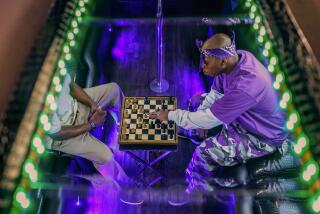A not-so-frivolous effort to win a mere game
- Share via
If you are deeply into computers or chess, “Behind Deep Blue” will fascinate and exhilarate you. And if you’re interested in learning about the differences between Chinese and American educational systems, this book will be extremely insightful.
Even if you have only a passing acquaintance with these things, you can still read with profit Feng-Hsiung Hsu’s account of the 12-year effort to create the machine that, in May 1997, defeated the world chess champion, Garry Kasparov.
This was not, Hsu firmly and rightly insists, a contest between man and machine. “The contest,” he writes, “was really between men in two different roles: man as a performer and man as a toolmaker.” In the 1996 match between Kasparov and an IBM computer, Hsu says, man as performer -- Kasparov -- won; in the 1997 match between Kasparov and the earlier computer’s successor, Deep Blue, man as toolmaker won.
Hsu was the leader of the team that designed the victorious Deep Blue. When he got the notion that a computer could be built that could challenge the world chess champion, chess was already being played by computers. Hsu’s singular idea, which came to him when he was a graduate student at Carnegie Mellon University in Pittsburgh, was that a computer could be made powerful enough to take on the most powerful human mind in chess.
Hsu’s account is written in an easy, flowing style, and, as he says, it is rather light-hearted. He attributes this style to two reasons: his belief that building a computer to play chess is “seemingly frivolous” and his great admiration for the late Nobel laureate Richard P. Feynman, who gave a light, humorous touch to his book “ ‘Surely You’re Joking, Mr. Feynman!’: Adventures of a Curious Character.”
The point that Hsu makes is that building and programming a computer that can calculate 2 million chess moves a second is not frivolous, and Feynman was not joking. All science is a kind of play, in the sense of a play of mind.
Hsu says of himself that he was “lazy” and didn’t like to work very hard when he as growing up in Taiwan. Others would study continuously; Hsu would study only on the night before an exam, when he simply filled his head with what he had to know. The Chinese educational system dated from the Tang Dynasty, which put in place a rigid system of examinations, based strictly on memorization, that were intended to ensure high places for smart Chinese regardless of social station. This system, Hsu writes, does not reward mental fluidity and innovation as the American system does.
Hsu’s lightning-quick, acquisitive intelligence got him in trouble through a couple of pranks at Carnegie Mellon, until he conceived of his chess-playing computer. When he and the team he formed there moved on to IBM -- “Big Blue” -- they ran into some unaccustomed bureaucracy but also got the enthusiastic backing of the giant firm.
Most of “Behind Deep Blue” is Hsu’s tale of encountering and overcoming obstacles in the design and programming of the computer to enable it to play chess like a human being. The technical aspects of both computers and chess will be fully comprehensible only to those with the appropriate experience and skill. The human story, though, is clear and exciting: adversity encountered, challenges met, all with the human elements of pride and anxiety and triumph. And the human elements, too, of anger and resentment.
Hsu recounts how, during a news conference in the midst of the 1997 contest, Kasparov accused the IBM team of interjecting a human move into Deep Blue’s calculations, an accusation, that is, of cheating. We do not have from Hsu a fuller account of Kasparov’s complaint. Hsu and his colleagues plausibly deny it, and in any case Kasparov has never again played against a powerful computer.
More to Read
Sign up for our Book Club newsletter
Get the latest news, events and more from the Los Angeles Times Book Club, and help us get L.A. reading and talking.
You may occasionally receive promotional content from the Los Angeles Times.










